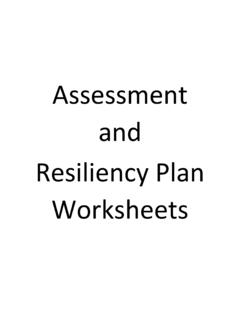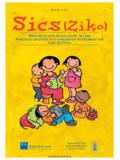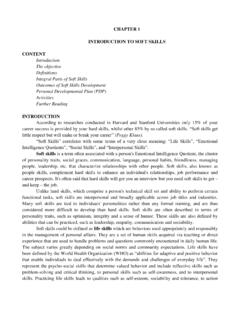Transcription of INTRODUCTION TO THE TF-CBT TOOLKIT - Mindful …
1 TRAUMA-FOCUSED COGNITIVE-BEHAVIORAL THERAPY INTRODUCTION TO THE TF-CBT TOOLKIT Congratulations on completing the online training in TF-CBT ! (If you haven t there is still plenty of time to complete this at ). We hope it has piqued your interest in providing evidence-based treatment services to traumatized children and their caregivers. We know the online training is not perfect. We would rate it good (three stars on a four star rating scale). But we also think it is the best INTRODUCTION to TF-CBT . Expert clinicians in TF-CBT strongly believe, however, that clinicians need more than just the online training in order to be prepared to deliver TF-CBT effectively. The usual recommended course of training is to follow-up the TF-CBT online training with in-person training and then ongoing clinical consultation with a TF-CBT expert until you have mastered TF-CBT . This course of training is not possible for most of us. That is why the developers of TF-CBT and researchers and clinicians at the University of Missouri in Columbia and Washington University in St.
2 Louis have packaged a set of scaffolded learning components designed to help you learn and deliver TF-CBT effectively in your practice setting. These activities are based on the educational science of scaffolded learning. Scaffolded learning is designed to optimize your skill acquisition by taking advantage of and respecting your existing knowledge and expertise, and tailoring the learning process to your individual needs. It puts you in charge of your learning. Scaffolded learning consists of four main components: (a) new knowledge and skills (in this case, TF-CBT ); (b) materials designed to help you recall and apply the skills; (c) a set of systematic and sequenced activities and tasks designed to help you practice and master the skills; and (d) expert and peer support for trying out the new skills. Individual learners employ these components to tailor a package to best meet their learning needs, using them when and how they find them most helpful, and proceeding at their own pace.
3 That being said, the TF-CBT developers and trainers believe that you will get the most out of this training package when you make use of all its components. The TF-CBT Learning Package includes eight parts designed to provide you with the content, materials, activities and support you need to deliver TF-CBT effectively: 1. TF-CBT Online Training If you have not yet started your TF-CBT learning, we strongly suggest you begin with the online TF-CBT training offered through the Medical University of South Carolina. Go to 2. TF-CBT Book We have included the book, Treating Trauma and Traumatic Grief in Children, written by the developers of TF-CBT . The book serves as the treatment manual for TF-CBT . The authors recommend you read the book soon after taking the online TF-CBT training. 3. TF-CBT TOOLKIT We have also included this TOOLKIT of materials designed to help you recall key concepts from TF-CBT and apply them with your clients. It includes several of the materials mentioned in the TF-CBT book.
4 We encourage you to look through the TOOLKIT and see what you find most helpful. We will be sending additional pieces to add to your TOOLKIT over the course of the training. 4. TF-CBT Learning Activities Our TOOLKIT includes a number of learning activities designed to help you practice the skills of TF-CBT . Most of these are practice activities, where you and another clinician role play using the skills and components of TF-CBT . Some of these activities reflect TF-CBT components demonstrated in the online training. Others are additional skills vital to the successful delivery of TF-CBT . These activities allow you to practice before you use TF-CBT with clients. These activities also include videos of expert TF-CBT clinicians modeling some of these skills, discussion questions, and other assignments to encourage you to think more deeply about your implementation of TF-CBT . If you are learning TF-CBT in an agency setting with other clinicians, the learning activities have been designed to walk you and your group through a sequence of role plays and discussion questions.
5 If you are learning TF-CBT mostly on your own, we will provide you with contact information for a learning partner with whom we encourage you to meet to go over these learning activities, practice and discuss TF-CBT . You are also welcome to identify your own learning partner. We think these learning activities are key. The role-plays and discussion questions are designed to help you practice the treatment components of TF-CBT with a few straightforward case examples. As you gain more comfort with the model, we also encourage you and your learning partner(s) to discuss how you would apply TF-CBT with more complex cases ( , multiple traumas, children in foster care). You can choose which skills are most important for you to practice, but we believe practice is a must. Some of these TF-CBT skills are not as easy as they may first seem! 5. TF-CBT Webinars We will provide you with free access to four webinars presented by the TF-CBT developers Drs. Judith Cohen, Esther Deblinger, and Anthony Mannarino.
6 We are really excited to be able to bring this opportunity to Missouri clinicians. They will teach you the secrets of doing TF-CBT well, using the experiences of their trainees across the country as their guides. 6. TF-CBT Workshop We will also provide two free in-person workshops with a TF-CBT expert trainer Margaret Comford, LCSW that you can choose to attend. One of these workshops will take place in St Louis and one in Columbia. During these workshops, you will be provided with more in-depth training in TF-CBT and be able to ask about applying and using TF-CBT in your practice ( , how to apply TF-CBT with the kinds of children and families you see). 7. TF-CBT Phone Consultation As you move forward with integrating TF-CBT into your practice, we have also arranged for free access to monthly phone consultations with a TF-CBT expert trainer. These phone calls will provide you with the opportunity to ask questions and seek input from a TF-CBT expert. These calls will also be an opportunity to listen and learn from the questions and answers with other trainees.
7 8. TF-CBT Online Discussion Board We have developed an online discussion board for TF-CBT at the Missouri Therapy Network web site. Here you can post questions about TF-CBT and read others questions and the answers they received from others who are learning the same skills and applying them in their clinical practices. The online discussion board will also be monitored by a certified trainer in TF-CBT , ensuring that you get expert answers when needed. Visit 9. TF-CBT Online Consult You also may want to consider making use of a new free resource offered through the Medical University of South Carolina (the same group that provides the initial free web training). This resource is called TF-CBT Consult and can be accessed at 10. TF-CBT Emailed Tips We will also periodically email you with TF-CBT implementation tips, clinical tips, and suggestions for rounding out your TF-CBT training. 11. Website of TF-CBT Resources The Missouri Therapy Network has also developed a website repository of resources for clinicians using TF-CBT .
8 It includes links to additional training videos, books, discussions, measures and more. Online resources can be found at YOUR NEXT STEPS: If you have not completed the online TF-CBT training, we encourage you to do so. Go to If you have completed the online training in TF-CBT , the next recommended steps are: (1) Read the book, Treating Trauma and Traumatic Grief. Some will want to read it cover to cover. It is a pretty quick read. Others will want to focus on areas where they know the least, or on the areas where the book provides substantially more detail than the online training. (2) Look through the TOOLKIT . Let us know what you find to be most helpful. We will be in touch soon!! Kristin Hawley, University of Missouri, Columbia Curtis McMillen, University of Chicago Enola Proctor, Washington University in St. Louis TRAUMA-FOCUSED COGNITIVE-BEHAVIORAL THERAPY TABLE OF CONTENTS We have started this notebook of helpful handouts and reminder sheets for using TF-CBT with your clients.
9 These materials are a starter TOOLKIT that you can add to over time. We hope to send you additions to your TOOLKIT as we learn from each other. TF-CBT Model TF-CBT Memory Jogger Assessment and Treatment Planning with TF-CBT CRAFTS acronym for TF-CBT assessment and treatment planning domains Assessment tips Sample TF-CBT treatment plan for submission to Missouri Healthnet Sample frequency rating sheet Frequency rating sheet TF-CBT fidelity checklist TF-CBT treatment steps tracking form TF-CBT supervisor s adherence checklist TF-CBT supervisee rating form Psychoeducation about trauma Educating children and families about trauma and TF-CBT How stress and PTSD affect our bodies Domestic violence handout for caregivers Domestic violence handout for children Child physical abuse handout for caregivers Child physical abuse handout for children Child sexual abuse handout for caregivers Child sexual abuse handout for children Parenting Skills Relaxation Controlled diaphragmatic breathing instructions Relaxation script for children Relaxation script for adolescents and adults Affective modulation
10 Ways to feel better right now Problem solving steps Cognitive coping and processing Cognitive Model: Thinking, Feeling, Doing Triangle Dog poop example of cognitive model BLUE acronym for types of unhelpful thinking Four strategies for disputing unhelpful/unhealthy thoughts Double Bubble worksheet for challenging unhelpful thinking Practicing the cognitive triangle Challenging your thinking mistakes Trauma narrative Helpful hints for the trauma narrative In vivo mastery of trauma reminders Subjective Units of Distress Scales (SUDS) Conjoint child-parent sessions Enhancing future safety and development TF-CBT Memory Jogger CRAFTS I: Core Values Components-based treatment emphasizing a set of skills that progressively build on previously acquired skills. Rather than a rigid session-by-session approach, TF-CBT has interrelated components, provided in a manner that best matches the needs of the child and family.






